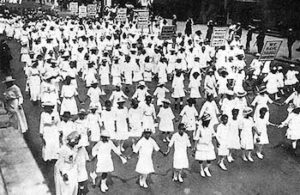
*On this date, 1917, the NAACP staged its first silent protest rally against lynching. Nearly fifteen thousand Blacks marched down Manhattan's Fifth Avenue, demonstrating their support for a government stoppage of lynching, race riots, and denying equal rights.
A post-Reconstruction fact: these murders were ongoing in the last decades of the nineteenth century and the beginning decades of the twentieth century. The lynching of Black people in the Southern and Border States became an institutionalized method used by whites to terrorize African Americans and maintain white supremacy. Mainly in the South, from 1880 to 1940, there was deep-seated and all-pervading hatred and fear of the Negro, which led white mobs to turn to “lynch law” as a means of social control. Lynchings, open public murders of individuals suspected of crime, conceived and carried out spontaneously by a mob, seem to have been an American invention.
Most of the lynching was by hanging, shooting, or both. However, many were more hideous, burning at the stake, maiming, dismemberment, castration, and other brutal methods of physical torture. Lynching was a cruel combination of racism and sadism, which was utilized primarily to sustain the caste system in the South. Many white people believed that Negroes could only be controlled by fear. To them, lynching was seen as the most effective means of control. Before 1882, no reliable statistics of lynching were recorded. That year, the Chicago Tribune first began to take systematic account of lynching. Shortly thereafter, in 1892, the Tuskegee Institute began to collect and systematically tabulate lynching statistics.
Beginning in 1912, the NAACP kept an independent record of lynching. These statistics were based primarily on newspaper reports. Because the South is so large and the rural districts had not always been in close contact with the city newspapers, many lynchings indeed escaped publicity in the press. The largest number of lynchings recorded occurred in 1892, with 230 persons lynched that year.
In 1919, termed the “Red Summer of Hate,” over one hundred Blacks were lynched as the Ku Klux Klan held more than two hundred meetings nationwide to launch arbitrary lynching, shootings, and other acts of violence against Black people. Many were World War I veterans; mobs even burned eleven men at the stake. Race riots occurred in twenty-five cities from April to early October 1919.
The largest occurred in Chicago, where thirty-eight people of both races died, and five hundred were injured. Other serious confrontations happened in Elaine, Arkansas; Charleston, South Carolina; Knoxville, Tennessee; Longview, Texas; Omaha, Nebraska; and Washington, D.C. Undoubtedly, there are errors and inaccuracies in the available lynching statistics. According to the Tuskegee Institute figures, between 1882 and 1951, 4,730 people were lynched in the United States. Several factors led to the violence.

Many Blacks were pitted against whites to obtain jobs and housing in northern cities. Blacks had more aspirations of political power and wealth, mainly because their current generation was born after emancipation. Those returning from the war, in particular, believed that they would be rewarded for their efforts in defeating Germany, but these hopes were (in general) not realized. The country wanted to keep Blacks at the bottom of the social, political, and economic ladder.
Never before had retaliatory violence been so widespread. Some suggested that a “New Negro” was emerging, one who would retaliate if attacked. These circumstances were compounded by the prevailing white mistrust of all things “alien” in postwar America, including Blacks. The “Red Scare” translated into beatings of those foreign-born, mass arrests of radicals, and raids on left-wing organizations.
The African American Desk Reference
Schomburg Center for Research in Black Culture
Copyright 1999 The Stonesong Press Inc. and
The New York Public Library, John Wiley & Sons, Inc. Pub.
ISBN 0-471-23924-0